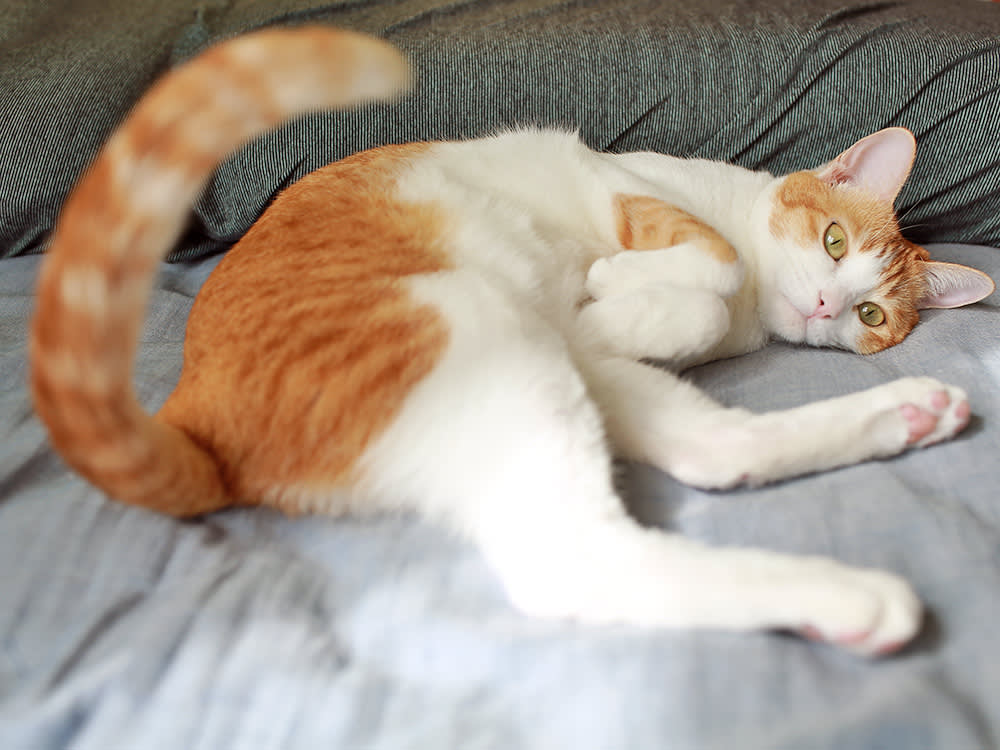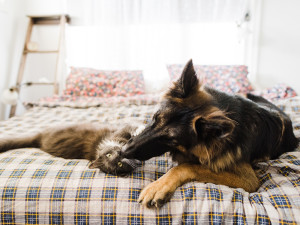What Does it Mean When a Cat Wags Their Tail? Guide to Cat Tail Language
And what does each type of wag mean about your cat’s mood?

Share Article
In This Article:
Why Do Cats Wag Their Tails? Understanding Cat Tail Language How to Keep Your Cat’s Tail Wag Happy
We all know what it means whe n dogs wag their tails: They’re happy, playful, and feeling unthreatened. However, when cats wag their tails, it’s often far more complicated. There are many reasons why a cat might wag their tail, and it’s not always as straightforward as wanting to play. In fact, misreading a cat’s wagging tail or assuming that it means the same as it does for a dog is actually a pretty easy way to get yourself swatted.
Cats have a ton of different, complicated ways of communicating with you, and by reading them properly, you can improve your bond with your cat and ensure that you always keep them happy. You also need to remember to read other clues in tandem with the tail wagging. If your cat is purring while wagging, it might mean something different than if they’re hissing while wagging.
While cats can be more difficult to read than dogs, it’s so rewarding once you figure out how to communicate with each other. With our guide, you can learn to interpret what your cat is trying to tell you with the complicated language of their tail.
Main takeaways
When a cat wags their tail, they’re trying to communicate something.
A cat wagging their tail can mean very different things than a dog’s tail wag.
In fact, many cats wag their tails to express discomfort and anger, not just happiness or playfulness.
You need to learn to read all of the signals that your cat is trying to convey to you with their tail and body language.
Why do cats wag their tails?
Cats’ tails are highly expressive. Senior Veterinary Trainer Dr. Mandala Hunter-Ishikawa says, “cats can have tail movements that mean different things, and not all of them are positive.” However, “all of the tail movements express their emotions.” It takes a little bit of work to really understand what your cat’s tail is trying to say.
Understanding cat tail language
With our simple guide, you can start to understand what your cat is trying to tell you with their tail.
Low wagging (scared)
If you see your cat wagging their tail very low to the ground, it’s not usually good news. “Low tails usually mean they are anxious or frightened,” says Dr. Mandala. Additionally, it could be pain-related. If your cat wags their tail in this way, you may need to use other context clues to figure out if they are scared, upset, or in pain.
Thrashing (annoyed)
If your cat’s tail is thrashing or thumping on the ground, they’re definitely not having fun. In fact, says Dr. Mandala, they might be irritated and angry. If this happens, says Dr. Mandala, there are actions you should take. If you are petting or near the cat when they do this, “you should distance yourself and stop doing the activity,” she says. If you don’t do this, Dr. Mandala adds, your cat may feel threatened and start hissing, growling, swatting, or biting at you.
Slow swish (focused)
A very common kind of wagging tail that cat parents often see is a slow, gentle swish back and forth. If your cat swishes their tail from side to side, says Dr. Mandala, it usually means that they are very focused on something. It can also mean that they are showing predatory behavior (they might be ready to pounce) or that they are showing aggression towards another cat, animal or human. Again, the context clues are essential for understanding this one.
Quick swish (playful)
If your cat swishes their tail very quickly from side to side, there are a few different things that it could mean. On the one hand, says Dr. Mandala, it could mean they are annoyed. At the same time, however, it could mean they are feeling playful. You should keep an eye on the other clues. Are they playing with a toy? Are they being irritated by an external influence, like a dog or person? It should be easy to tell whether it’s a playful or irritated swish.
Quick twitch (focused)
If your cat’s tail is twitching quickly, it could mean they are simply very focused on something. If your cat is hunting or in a predatory mode, their tail might twitch quickly or subtly. This twitch indicates they’re focused, concentrating, and ready to pounce on their prey (which, of course, might just be a treat or toy).
Twitching at the end (frustration)
If just the end of their tail is twitching, says Dr. Mandala, it could indicate mild irritation or frustration. However, it can also happen if a cat is playing or hunting, not unlike the quick twitch detailed above. Dr. Mandala says that if you are petting or near the cat, be cautious if you see this end-of-tail twitch going. If they are being playful, they may swat at you to include you in their play. If they are hunting or irritated, the twitch could lead to anger, which could escalate to hissing, swatting, or biting. Basically, stay out of the way.
Quiver (excited)
If your cat’s tail is quivering or shaking very quickly, says Dr. Mandala, it could mean they are very excited. On the other hand, however, they could be urine marking. The context clues on this one are pretty easy to figure out.
Wrapping tail (love)
When your cat’s tail wraps back and forth, particularly around your leg, it’ “indicates a positive greeting towards humans or other cats,” says Dr. Mandala, adding that it shows a willingness to interact. We should think of it “like a hug to a friend,” says Dr. Mandala. Basically, if a cat is wrapping their tail at or around you, you shouldn’t worry too much about their mood changing or getting swatted.
Fluffed up tail (danger)
If your cat’s tail is fluffed up or standing on end, they are not happy. In fact, they are worried. A fluffed up tail shows that your cat believes there is danger nearby and they are worried about it. Particularly if there are other clues, including an arched back, you can interpret this as a kind of defense mechanism. If there is anything you can do to put your cat at ease without touching them, you should do it when you see their tail puffed up.
Sleep twitch (sleeping)
If you watch your cat sleep (who doesn’t?), you might have noticed their tail twitching in their sleep. Dr. Mandala says that a tail twitch in their sleep means that “the cat feels comfortable enough to keep sleeping. They are acknowledging your presence but don’t feel it necessary to wake up.” Basically, they know you’re watching them sleep, but they don’t mind.
Waving tail while lying down (pain)
Cats don’t have words to tell you when they’re in pain or stressed. However, what they do have is their body language, such as how they talk to you with their tail. If your cat is lying down and waving their tail around, unfortunately, they might be trying to communicate that they’re in pain. If your cat is doing this and not otherwise acting in a way you expect from them, you should contact your vet.
How to keep your cat’s tail wag happy
Understandably, if you have a cat, you want to keep them happy at all times. Unfortunately, external factors might stress them out or make them scared or unhappy, no matter what you do. Dr. Mandala says that you need to look at other clues besides the tail to make sure that your cat is happy. “They are always communicating with us through facial expressions (whiskers, ear positions), vocalizations, if they are rubbing their cheeks/mouth area, if their wagging is accompanied by purring or chirrup sounds while the other clues are present,” she says. All cats are different, and if you want to understand what your cat is trying to tell you, you need to learn to read all of the signs they’re trying to communicate to you.
References
Deputte, Bertrand L., et al. “Heads and Tails: An Analysis of Visual Signals in Cats, Felis Catus.” Animals, vol. 11, no. 9, 21 Sept. 2021, p. 2752, https://doi.org/10.3390/ani11092752opens in new tab.
Wales, Jennifer Lee. “Tail Wagging– What Does It Mean?” Psu.edu, 18 Oct. 2015, sites.psu.edu/siowfa15/2015/10/18/tail-wagging-what-does-it-mean/opens in new tab.

Marianne Eloise
Marianne Eloise is a writer for outlets like The Cut, the Guardian and the New York Times. She is also the author of an essay collection Obsessive, Intrusive, Magical Thinkingopens in new tab. She has been going on adventures with her dog Bowie since she was 17.
Related articles
![A German shepherd and cat play affectionately in a bed.]()
Cats vs. Dogs: Behavior, Intelligence, and Care Similarities and Differences
There’s no winning this argument, but here’s what you should know about parenting your new pet.
![dark-haired woman hugging cat that has imprinted on her]()
10 Signs Your Cat Has Imprinted on You
Feeling like you have a little shadow these days? Here’s why that’s happening.
![Cat grabbing onto ledge of table and looking to the left]()
Why Does My Cat Follow Me Everywhere?
Yes, they are right behind you.
![Woman With A Book And Her Cute Cat At Home.]()
In “Kitty Language,” Lili Chin Draws You a Literal Cheat Code to Your Cat
The author and artist uses informative (and freakin’ adorable) images to teach cat parents everything about kitty communication.
Why Does My Cat’s Tail Vibrate?
They’re trying to tell you something... but what?







